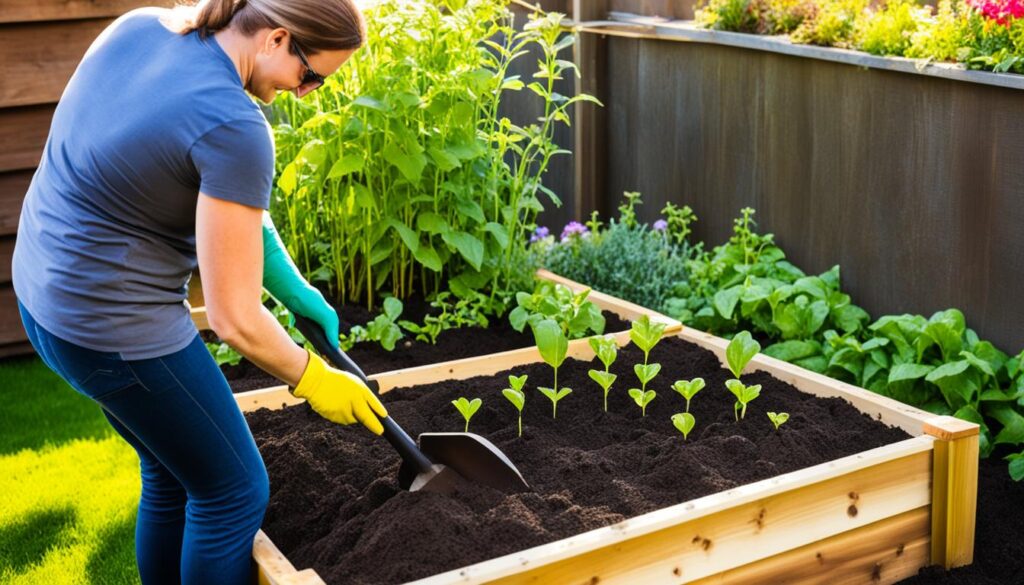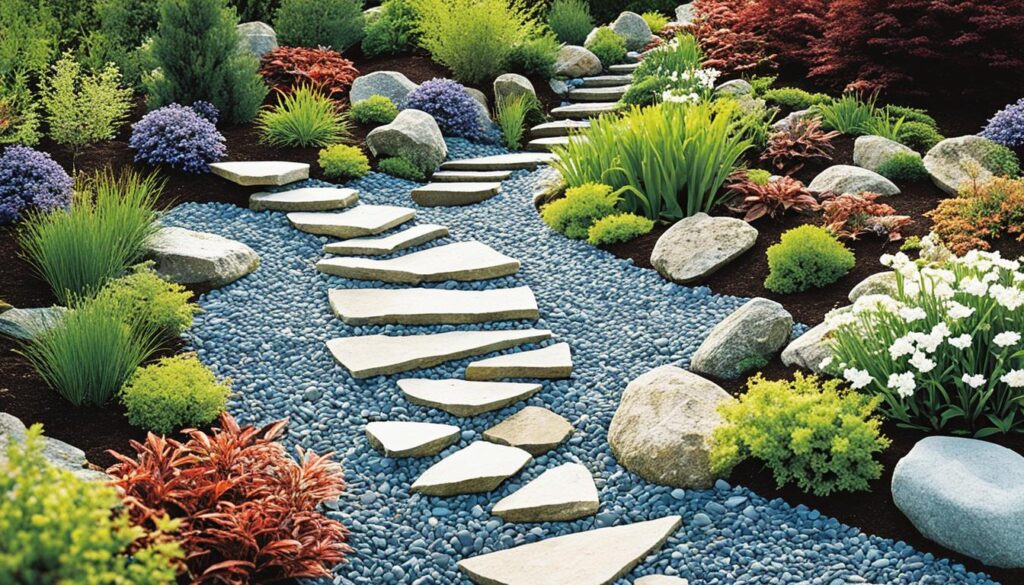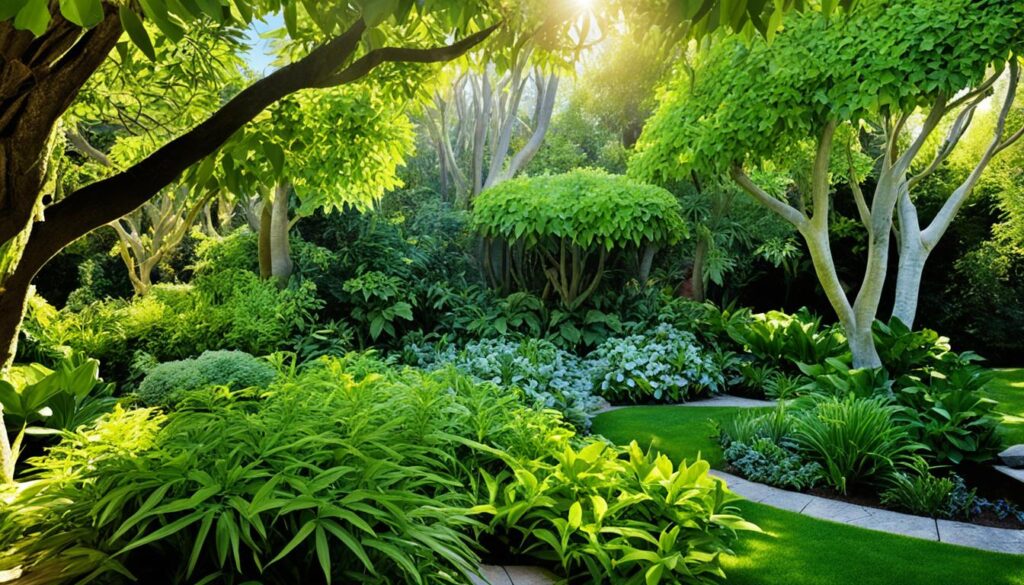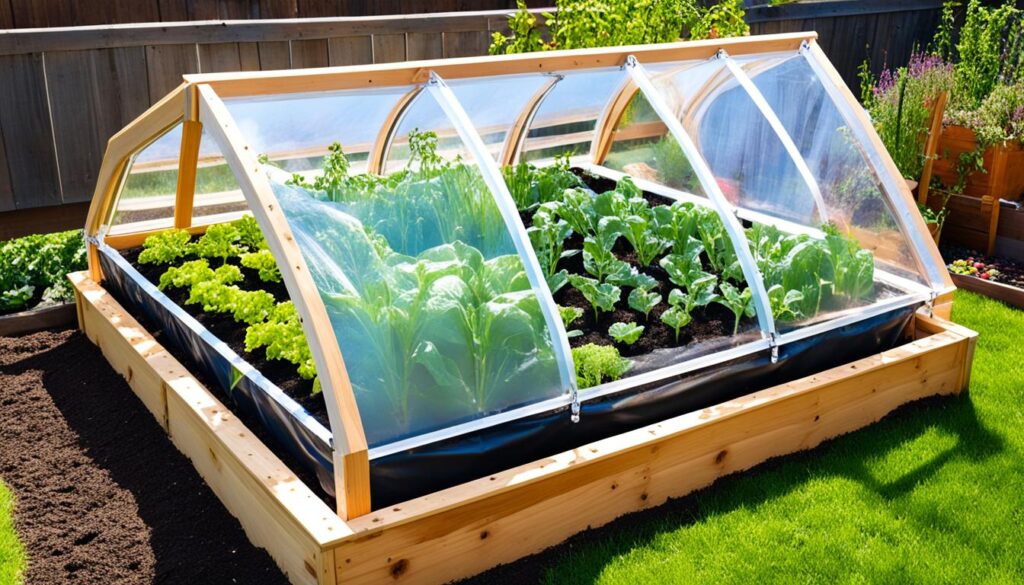Making your own wooden planters from decking boards is a fun and rewarding DIY project. By following a few simple steps, you can create beautiful and functional planters to add greenery and colour to your garden. In this guide, I will provide you with all the information you need to successfully make wooden planters from decking.
Key Takeaways
- Learn how to make wooden planters from decking boards
- Discover creative ideas for DIY wooden planters
- Follow a step-by-step tutorial for building decking planters
- Enhance the look of your planters with finishing touches
- Enjoy the benefits of making your own wooden planters
Gather the Materials and Tools
Before you start building your wooden planters, gather all the necessary materials and tools. It’s essential to have everything you need to ensure a smooth and efficient construction process.
Materials for Wooden Planters
Here are the materials you’ll need:
- Decking planks
- Treated timber
- Timber offcuts
- Decking screws
- Clout nails
- Polythene or pond liner
- Multi-purpose compost
- Broken garden pots or stones for drainage
Tools for Wooden Planter Construction
In addition to the materials, you’ll require the following tools:
- Hammer
- Screwdriver
- Chop saw
- Jigsaw
- Circular saw
- Staple gun
Having these materials and tools on hand will ensure that you can proceed with your wooden planter construction without any interruptions. So gather everything you need and let’s get started!
Plan and Measure
In order to successfully build wooden planters, careful planning and precise measurements are essential. Taking the time to plan out the size and shape of your planters will ensure that they fit perfectly in your garden and complement your overall design. Additionally, accurate measurements will guarantee that you have all the necessary parts and materials for a smooth construction process.
To begin, decide on the dimensions of your planters. Consider the available space in your garden and the types of plants you intend to grow. Will you be placing them on a patio, balcony, or directly on the ground? This will determine the size and height of your planters. Once you have a clear idea of the desired dimensions, create a cutting list detailing the required parts.
Pro Tip: It is recommended to cut a “master” piece from one of the decking planks. Use this piece as a template to ensure uniformity in size and shape for the rest of the planters.
Now it’s time to measure and cut the decking planks, timber, and offcuts according to your predetermined dimensions. Use a tape measure or ruler to ensure accuracy. Remember to double-check your measurements before cutting to avoid any mistakes. Taking the time to measure correctly will save you time and effort in the long run.
Example Cutting List:
| Part | Number of Pieces | Dimensions |
|---|---|---|
| Decking Planks | 4 | 50cm x 10cm |
| Treated Timber (legs) | 2 | 70cm x 10cm |
| Treated Timber (supports) | 2 | 50cm x 2.5cm |
| Timber Offcuts (corner braces) | 4 | 10cm x 5cm |
By following these planning and measuring steps, you’ll be well-prepared to tackle the construction phase of building your wooden planters. So take your time, think through the details, and ensure that your planters are the perfect fit for your garden.
Cutting and Construction
Once you have all the necessary parts cut to size, it’s time to start construction. Use clamps to hold the pieces together as you assemble the corners and legs.
Screw the decking planks to the legs, ensuring a screw in each corner. Attach the remaining side pieces and secure them with screws. Finally, attach the middle legs and slat supports to strengthen the structure of the planter.
| Steps for Cutting and Construction |
|---|
| 1. Gather all the necessary cut parts |
| 2. Use clamps to hold the pieces together |
| 3. Screw the decking planks to the legs |
| 4. Attach the remaining side pieces |
| 5. Secure the side pieces with screws |
| 6. Attach the middle legs and slat supports for added strength |
With these simple steps, you can construct sturdy and durable wooden planters from decking. The clamps will ensure precise assembly, while the screws will provide stability. Remember to follow the cutting dimensions carefully to ensure a perfect fit. Get ready to see your garden transformed with these beautiful planters!
Enhancing the Look
To make your wooden planters look more professional, consider adding some finishing touches. Chamfer the edges of the longer side pieces for a polished look. Chamfer the bottoms of the legs to prevent wood splitting. You can also paint or stain the planters to suit your personal preferences and the aesthetic of your garden. These enhancements will make your planters stand out.
Adding a chamfer to the edges of the longer side pieces gives your wooden planters a clean and refined appearance. The angled edges not only enhance the visual appeal but also provide a smooth finish that prevents splintering.
Paying attention to the bottoms of the legs is equally important. By chamfering them, you can safeguard against potential wood splitting caused by moisture or external factors. This small detail can significantly extend the lifespan of your planters.
If you want to add a pop of color or match your planters with your garden’s aesthetic, try painting or staining them. Choose a high-quality outdoor wood paint or stain that complements your outdoor space. Whether you prefer a classic white finish or a bold and vibrant color, painting or staining your planters will give them a personalized touch.
Remember, the finishing touches on your wooden planters are the key to making them truly stand out. Consider your garden’s overall style and choose the enhancements that best suit your taste. Whether it’s chamfering the edges or adding a splash of color, these simple yet effective techniques will transform your planters into stunning focal points in your garden.

| Enhancements | Benefits |
|---|---|
| Chamfering the edges | – Gives a polished and refined look – Prevents splintering |
| Chamfering the bottoms of legs | – Prevents wood splitting – Increases durability |
| Painting or staining | – Personalizes the planters – Matches the garden’s aesthetic |
Adding the Base and Lining
The base of the wooden planter is crucial for stability and proper drainage. To ensure stability, you need to consider the type of surface the planter will be placed on. If it’s going on soil, a cardboard base can be used to provide support. However, if you’re placing the planter on a concrete patio or any hard surface, you’ll need to take additional steps.
If your planter will be on a concrete patio, it’s important to create drainage holes in the base. These holes will prevent waterlogging and help maintain the health of your plants. To line the planter, use a landscape fabric liner that can be stapled inside. This liner acts as a barrier, allowing water to drain while preventing soil from escaping.
Another important consideration is protecting the wood of the planter. To avoid direct contact between the soil and the wood, line the inside of the planter with plastic. This lining will help protect the wood from moisture and extend the lifespan of your planter.

Base and Lining Options
| Surface | Base | Lining |
|---|---|---|
| Soil | Cardboard | Plastic |
| Concrete Patio | Drainage Holes | Landscape Fabric Liner |
Filling and Planting
Once your wooden planters are constructed and lined, it’s time to fill them with soil or compost. Adding the right amount of soil or compost is crucial for the health and growth of your plants. I recommend following these steps to ensure successful planting in your decking planters:
- Add a layer of broken garden pots or stones at the bottom of the planter. This layer will help with drainage, preventing water from sitting at the roots of your plants.
- Fill the planters with the appropriate amount of multi-purpose compost. The depth of the compost should be enough to accommodate the root systems of your chosen plants.
- Consider mixing in some organic matter, such as well-rotted manure or compost, to enrich the soil and provide nutrients to your plants.
- Now it’s time to start planting! Choose plants that are suitable for the size and location of your wooden planters.
- If you’re not sure which plants to choose, you can consult gardening books or websites, or seek advice from your local garden center.
- When planting, make sure to space the plants properly to allow for their growth. Follow the specific planting instructions for each type of plant.
- Water your newly planted flowers, herbs, or vegetables thoroughly after planting, and continue to water them regularly as needed.
By following these planting guidelines, you can create a thriving garden in your wooden planters and enjoy the beauty of nature right in your own backyard.
My Planting Tips:
When choosing plants for your decking planters, consider the amount of sunlight the area receives. Some plants thrive in full sun, while others prefer partial shade. It’s important to select plants that match the sun exposure of your planter location to ensure their successful growth.

With proper filling and planting, your wooden planters will become vibrant and colorful focal points in your garden. Take your time to select the right plants and enjoy the process of watching them flourish and bloom.
Other Planter Ideas
Wooden planters offer endless possibilities for creativity. Take a look at the images provided for inspiration. You can create different shapes, sizes, and designs to suit your garden’s aesthetic. Consider integrating benches or pot stands into your planters for added functionality. Let your imagination run wild and create unique wooden planters that reflect your personal style.
| Planter Idea | Description |
|---|---|
| Tiered Planter | Create a stunning focal point in your garden with a tiered planter. Stack wooden planters of decreasing sizes on top of each other, filling each level with vibrant flowers or cascading vines. |
| Hanging Planter | Add visual interest and save space by hanging wooden planters from a pergola or fence. Use sturdy ropes or chains to suspend the planters at different heights, creating a striking and dynamic display of greenery. |
| Vertical Planter Wall | Maximize your planting space by building a vertical planter wall. Attach wooden planters to a sturdy frame and stack them vertically. This unique design not only saves space but also adds a contemporary touch to your garden. |
| Sculptural Planter | Get creative with your wooden planters and experiment with different shapes and forms. Whether it’s a geometric sculpture or an abstract design, a sculptural planter will make a bold statement in your garden. |
These are just a few ideas to get you started. Let your imagination guide you and think outside the box when it comes to designing your wooden planters. The possibilities are endless, and you’re sure to create a unique and eye-catching display for your plants.
Benefits of Making Wooden Planters
When it comes to gardening, wooden planters offer a multitude of advantages. Not only do they provide a beautiful and natural aesthetic, but they also allow you to fully customize your planters according to your preferences and garden design. Let’s explore the benefits of making your own wooden planters from decking boards:
1. Customization
Making your own wooden planters gives you the freedom to tailor the size, shape, and design to perfectly fit your gardening needs. Whether you want a sleek rectangular planter or a unique tiered design, the possibilities are endless. By adding a personal touch to your planters, you can create a standout feature in your garden that reflects your style and taste.
2. Cost-effective Option
DIY wooden planters can be a cost-effective choice, especially if you choose to repurpose materials. By using decking boards or repurposing pallets, you can significantly reduce the cost of materials. This makes it a budget-friendly alternative to purchasing pre-made planters from stores. Plus, you’ll have the satisfaction of creating something beautiful with your own hands.
3. Rewarding and Enjoyable
Building and planting your own wooden planters can be a fulfilling and enjoyable DIY project. It allows you to connect with nature, exercise your creativity, and develop your gardening skills. The process of constructing the planters and watching your plants thrive in them can provide a sense of accomplishment and pride. It’s a gratifying experience that allows you to take ownership of your garden.
Overall, making your own wooden planters from decking offers a range of benefits. From customization to cost-effectiveness, this DIY project allows you to create unique, personalized planters that enhance the beauty of your garden. So, roll up your sleeves, grab your tools, and embark on a rewarding journey of building your own wooden planters.
Note: The image above showcases the endless possibilities and advantages of wooden planters.
Conclusion
Making wooden planters from decking is a rewarding and enjoyable DIY project that allows you to add a personal touch to your garden. By following the steps outlined in this guide and using your imagination, you can create unique and functional planters that will showcase your favorite plants in style.
Whether you’re a seasoned DIYer or a beginner, building your own wooden planters is a satisfying endeavor that will bring beauty and greenery to your outdoor space. Remember to gather all the necessary materials and tools, plan and measure the dimensions carefully, and construct the planters with precision.
With the right techniques and attention to detail, you can create beautifully crafted planters that will enhance the aesthetic of your garden. So, grab your tools, get creative, and enjoy the process of making DIY decking planters. Your garden will thank you for it!








